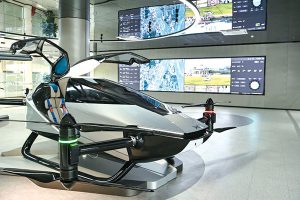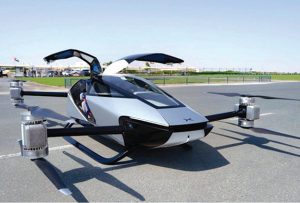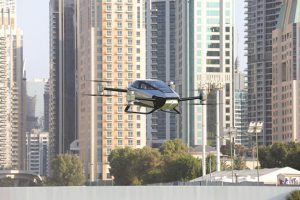Bloomberg
The crowd of hundreds roared in Mandarin as the gull-winged two-seater aircraft rose and hovered roughly 30 meters (100 feet) above their heads, before smoothly lowering back down to earth.
In the past months, China’s Xpeng Aeroht has staged two maiden public flights for its aircraft. The 90-second exercise in October was followed by another in Guangzhou, China — landmarks for the startup backed by electric-vehicle maker Xpeng Inc. The EV firm’s billionaire founder He Xiaopeng and other backers are betting large they can overcome regulatory hurdles and capture a slice of what’s been touted as a $1 trillion market that could
redefine how we move around.
“The flying car is approaching reality and we think it was the right time to chip in,†Brian Gu, Xpeng’s president, said. “The industry has produced a lot of technical breakthroughs, from weight reduction to obstacle avoidance and electrification.â€
The hype belies the reality that rival startups have grappled with for years. Companies including Lilium, Joby Aviation and Archer Aviation wowed investors with multibillion-dollar listings but are now trading near historic lows. Google co-founder Larry Page’s KittyHawk shut in September.
Most investors expect company closures and industry consolidation in the coming years, even as orders gradually increase, according to a study commissioned by Canada’s Horizon Aircraft published this month.
Investors want to find “the Tesla of the flying car industry,†said Zhang Junyi, a partner at consultancy Oliver Wyman who helped establish Nio Capital. But it could take 10 to 15 years for the market to bloom. “Investing in the flying car industry is a tough marathon.â€
The prototype flown in Guangzhou makes Aeroht stand out. While many eVTOLs — electric vertical takeoff and landing aircraft — have no wheels and can’t be driven on the ground, the Chinese company’s sixth-generation model is an actual car that also works on the road. It looks like a luxury automobile rather than a small plane with wheels, which is some contenders’ approach.
In fact, the model is designed to be driven on the road for more than 90% of the time and only flown when there are traffic jams or obstacles. Founder Zhao said in an interview the car — which sports four electric engines and eight propellers — may go into mass production in 2025.
He envisions a price tag of about $140,000, a fraction of Joby’s vehicle ($1.3 million). That’s partly because Aeroht can tap Xpeng’s extensive chain of suppliers across China, he said.
The pursuit of eVTOLs dates back at least a decade, when entrepreneurs dreamed of democratising the skies. (Or, more prosaically, of soaring over what Elon Musk calls “soul-destroying†traffic.)
In ensuing years, the field got increasingly crowded as investors dreamed of bringing a vision that existed only in comic books and sci-fi into reality. Morgan Stanley analysts say the eVTOL or urban air mobility field could be worth $1 trillion by 2040.
Chinese firms including Aeroht, Ehang Holdings Ltd. and TCab Tech joined the race in about the past half-decade, drawing inspiration from American names such as Joby and Archer. They nurtured a generation of entrepreneurs and investors trying to replicate the success China’s had with EVs, employing many of the same advantages: an extensive supply chain, vast pool of skilled labour, giant domestic market and — importantly — official support.
Many are counting on President Xi Jinping’s effort to displace American technology in fields from semiconductors to climate technology to galvanize funding and policy assistance.
Some of the biggest names in startup investing agree, including IDG Capital, Sequoia China, GGV Capital and Hillhouse Capital — all backers of Aeroht. They joined a funding round of more than $500 million in 2021 at a valuation of $1.5 billion.
To be sure, the technology isn’t yet fully developed. Much hinges on the development of batteries with higher energy density — the amount of power versus its mass. As flying cars need more oomph and are more sensitive to loads, lighter and more capable batteries than those used in EVs are crucial. The batteries Aeroht now employs in prototypes are lab products from
domestic suppliers. Aeroht is betting true scale will be found in consumer products — but that’s where the steepest
regulatory hurdles remain.
 The Gulf Time Newspaper One of the finest business newspapers in the UAE brought to you by our professional writers and editors.
The Gulf Time Newspaper One of the finest business newspapers in the UAE brought to you by our professional writers and editors.



